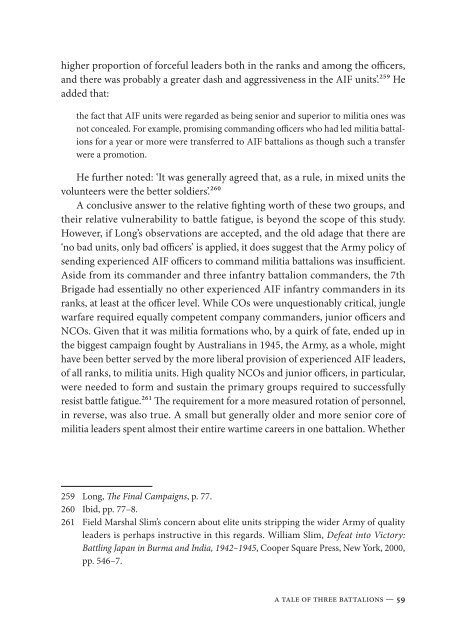View the pdf - Australian Army
View the pdf - Australian Army
View the pdf - Australian Army
You also want an ePaper? Increase the reach of your titles
YUMPU automatically turns print PDFs into web optimized ePapers that Google loves.
higher proportion of forceful leaders both in <strong>the</strong> ranks and among <strong>the</strong> officers,and <strong>the</strong>re was probably a greater dash and aggressiveness in <strong>the</strong> AIF units’.259 Headded that:<strong>the</strong> fact that AIF units were regarded as being senior and superior to militia ones wasnot concealed. For example, promising commanding officers who had led militia battalionsfor a year or more were transferred to AIF battalions as though such a transferwere a promotion.He fur<strong>the</strong>r noted: ‘It was generally agreed that, as a rule, in mixed units <strong>the</strong>volunteers were <strong>the</strong> better soldiers’.260A conclusive answer to <strong>the</strong> relative fighting worth of <strong>the</strong>se two groups, and<strong>the</strong>ir relative vulnerability to battle fatigue, is beyond <strong>the</strong> scope of this study.However, if Long’s observations are accepted, and <strong>the</strong> old adage that <strong>the</strong>re are‘no bad units, only bad officers’ is applied, it does suggest that <strong>the</strong> <strong>Army</strong> policy ofsending experienced AIF officers to command militia battalions was insufficient.Aside from its commander and three infantry battalion commanders, <strong>the</strong> 7thBrigade had essentially no o<strong>the</strong>r experienced AIF infantry commanders in itsranks, at least at <strong>the</strong> officer level. While COs were unquestionably critical, junglewarfare required equally competent company commanders, junior officers andNCOs. Given that it was militia formations who, by a quirk of fate, ended up in<strong>the</strong> biggest campaign fought by <strong>Australian</strong>s in 1945, <strong>the</strong> <strong>Army</strong>, as a whole, mighthave been better served by <strong>the</strong> more liberal provision of experienced AIF leaders,of all ranks, to militia units. High quality NCOs and junior officers, in particular,were needed to form and sustain <strong>the</strong> primary groups required to successfullyresist battle fatigue.261 The requirement for a more measured rotation of personnel,in reverse, was also true. A small but generally older and more senior core ofmilitia leaders spent almost <strong>the</strong>ir entire wartime careers in one battalion. Whe<strong>the</strong>r259 Long, The Final Campaigns, p. 77.260 Ibid, pp. 77–8.261 Field Marshal Slim’s concern about elite units stripping <strong>the</strong> wider <strong>Army</strong> of qualityleaders is perhaps instructive in this regards. William Slim, Defeat into Victory:Battling Japan in Burma and India, 1942–1945, Cooper Square Press, New York, 2000,pp. 546–7.A tale of three battalions — 59
















